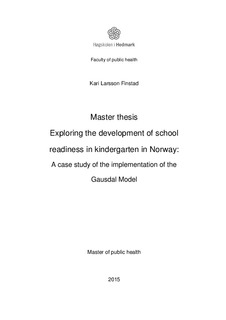Exploring the development of school readiness in kindergarten in Norway : A case study of the implementation of the Gausdal Model
Master thesis
Permanent lenke
http://hdl.handle.net/11250/2368608Utgivelsesdato
2015Metadata
Vis full innførselSammendrag
English abstract: Background: This research was initiated by a request from Gausdal municipality to have a master’s thesis written about the sensori-motoric project the Gausdal Model. One of the aims of the Gausdal Model is to better prepare children for school through a programme based on proportionate universalism. Aim: The aim was to explore key stakeholders understandings of school readiness and generate in-depth knowledge about their processes of implementation of the Gausdal Model. This could shed light on processes that develop children’s motor proficiency and its possible relation to school readiness. Methods: A case study of the implementation of the Gausdal Model was carried out in order to explore key stakeholders’ understanding of school readiness. The sample was strategic and the nine kindergarten teachers and parent informants were recruited from four municipal kindergartens in Gausdal. The health nurse connected to the programme was also an informant. Data were collected through qualitative interviews, partly informed by prior observations of the activities in the programme. The data analysis was inspired by principles from grounded theory as described by Charmaz (2014). The analysis aimed to identify components that could shed light on the processes that was studied. Bronfenbrenner’s ecological systems theory and Bandura’s social cognitive theory (SCT) and concept self-efficacy (SE), in particular were used as sensitising concepts in order to analyse the data and generate an understanding of how the Gausdal Model could develop children’s motor proficiency, and how this might be related to children’s school readiness. Results: The findings from the implementation of the Gausdal Model show that children’s motor proficiency can be understood as being developed through a process of socialisation where support through strong mesosystems and significant others, in this case kindergarten teachers and parents, could help develop the children’s mastery of their own bodies. At the mesosystem-level, quality and quantity of communication and aiming consistently towards the same goals was important. At the microsystem level, a combination of the four sources of SE and relational qualities between the kindergarten teachers and children seemed to develop children’s motoric SE and mastery of their own bodies. Motor proficiency seems to be related to school readiness through both the transferability of certain components of motoric SE as well as a social dimension, as social inclusion was an important component of school readiness. Hence, motor proficiency was related to a multidimensional understanding of school readiness. Conclusion: The Gausdal Model is in line with public health recommendations of early intervention and proportionate universalism, and has the potential to better prepare children for school as well as contributing to children’s socialization in general. Norsk sammendrag: Bakgrunn: Denne forskningen ble initiert av en forespørsel fra Gausdal kommune om å skrive en masteroppgave om det sanse-motoriske programmet Gausdalsmodellen. Et av målene for Gausdalsmodellen er å gi barn et bedre utgangspunkt for skolestart gjennom tiltak for alle – for å nå de få og styrke alle. Mål: Å utforske barnehagelærere, foreldre og helsesøsters forståelse av hva det vil si å være skoleforberedt og generere kunnskap om gjennomføringen av Gausdalsmodellen. Dette kan belyse prosesser som utvikler barnas motoriske ferdigheter, samt en mulig sammenheng mellom dette og det å være skoleforberedt. Metoder: En kasus-studie av gjennomføringen av Gausdalsmodellen og barnehagelærere, foreldre og helsesøsters forståelse av hva det vil si å være skoleforberedt. Utvalget er strategisk og ni informanter (barnehageansatte og foreldre) ble rekruttert fra fire kommunale barnehager i Gausdal. En helsesøster som arbeider med Gausdalsmodellen er også informant. Data ble samlet inn gjennom kvalitative intervjuer som blant annet ble utarbeidet på bakgrunn av observasjoner av aktiviteter i Gausdalsmodellen. Analysen av datamaterialet er inspirert av prinsipper fra grounded theory beskrevet av Charmaz (2014). Analysen tar sikte på å identifisere komponenter som kan kaste lys over de prosessene som ble studert. Bronfenbrenners utviklingsøkologiske modell og Banduras sosial kognitive teori og konseptet mestringsforventning, ble brukt for å for analysere datamaterialet og forstå hvordan gjennomføringen av Gausdalsmodellen kan utvikle barnas motoriske ferdigheter, samt hvordan disse ferdighetene kan knyttes til det å være skoleforberedt. Resultater: Funnene viser at barns motoriske ferdigheter kan forstås som å bli utviklet i en sosialiseringsprosess der støtte fra sterke mesosystemer og signifikante andre, i dette tilfellet barnehagelærere og foreldre, er av betydning. På mesosystem-nivå gjennom kvantitet og kvalitet på kommunikasjon og en felles målsetning rundt barnets utvikling. På mikronivå synes en kombinasjon av relasjonelle kvaliteter mellom barnehagelærerne og barna, og kilder til utvikling av barnas mestringsforventning, å bidra til barnas motoriske utvikling og kroppslige mestring. Motoriske ferdigheter synes å være knyttet til det å være skoleforberedt, både gjennom overførbarhet av visse komponenter av motorisk mestringsforventning, samt gjennom en sosial dimensjon hvor sosial inkludering var viktig for at barna skal være skoleforberedt. Derfor er motoriske ferdigheter knyttet til en helhetlig forståelse av hva det vil si å være skoleforberedt. Konklusjon: Gausdalsmodellen er i tråd med folkehelseanbefalinger om tidlig intervensjon og proposjonell universalisme og har potensiale til å forberede barna til skolestart i tillegg til å bidra i en generell sosialiseringsprosess.
